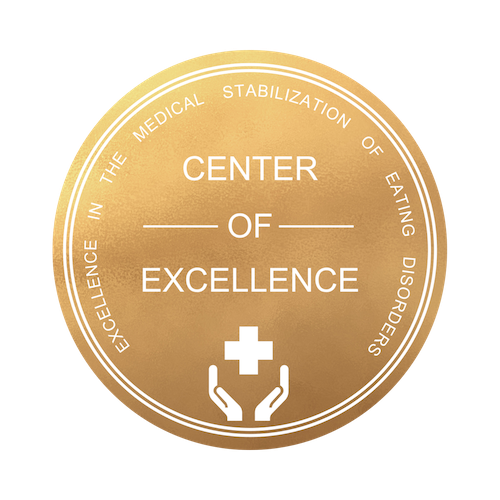
What is Bulimia Nervosa?
Bulimia nervosa (BN) is an eating disorder characterized by a dangerous cycle of bingeing and purging via compensatory behaviors to rid the body of ingested calories and prevent weight gain. Common methods of purging include self-induced vomiting and laxative abuse. Binges, or consuming a large quantity of food in a short period of time, are often followed by feelings of guilt or shame. The severity of bulimia nervosa is determined by the frequency of binge/purge episodes and the mode of purging.
Note: ACUTE’s hospital-based, inpatient medical stabilization unit is intended to treat patients with severe and extreme bulimia nervosa who are experiencing attendant medical complications or those who are at risk for life-threatening complications during purging cessation. However, medical issues can arise in mild or moderate forms of the illness as well, even in patients new to purging behaviors.
Symptoms of Severe Bulimia Nervosa (BN)
Recurrent episodes of binge eating (eating unusually large quantities of food in a short period of time with feelings of loss of control) followed by inappropriate weight compensatory behaviors (including self-induced vomiting, laxative or diuretic misuse, and excessive exercise) at least once-weekly during the past three months.
Severe bulimia nervosa (BN) is defined as 8–13 binge/purge episodes per week), and extreme bulimia nervosa involves 14 or more binge/purge episodes per week.
Unhealthy preoccupation with weight loss, body weight and shape; significant body image distortions.
Medical Complications of Severe Bulimia Nervosa (BN)
-
Cardiac Problems
Resting and exertional sinus tachycardia, hypotension, and orthostasis; prolonged QTc interval, arrhythmias, syncope and palpitations; ventricular tachycardia (torsades de pointes); ventricular arrhythmias, and sudden cardiac death (from emetine toxicity)
-
Gastrointestinal Problems
Gastroesophageal reflux (GERD), dysphagia, and odynophagia; esophagitis, esophageal erosions and ulcers, Barrett’s esophagus and bleeding; Boerhaave’s syndrome (esophageal rupture); diarrhea, melanosis coli, cathartic colon, constipation
-
Pulmonary Problems
Sudden onset respiratory distress, aspiration, pneumomediastinum
-
Multiple Endocrine Abnormalities
Dehydration, pseudo-Bartter’s syndrome, edema, electrolyte abnormalities (serum bicarbonate, sodium and potassium)
-
Throat Problems
Hoarseness, dysphagia, chronic cough, a burning sensation in the throat or repeated sore throats
-
Dental Problems
Dental erosion, reduced salivary flow rate, tooth hypersensitivity, dental caries, periodontal disease, and xerostomia (dry mouth), sialadenosis (enlargement of salivary glands)
-
Dermatologic Complications
Telogen effluvium, xerosis, hypertrichosis lanuginose, cheliosis, carotenoderma, pruritis, and nail fragility; skin abrasions and callus formation on the dorsal aspect of the hand (Russell’s sign)
-
Other Complications
Increased risk of miscarriages
Severe Bulimia Nervosa Facts
- Complications of bulimia nervosa are a direct result of both the mode and the frequency of purging behaviors.
- Self-induced vomiting and laxative abuse are the two major modes of purging, accounting for more than 90% of purging behaviors in bulimia nervosa.
- Other methods of purging include diuretic abuse, weight loss supplements, enemas and over-exercise, and are utilized less frequently in bulimia nervosa.
- Medical complications of bulimia nervosa are associated with the different purging methods; there are also medical complications associated with abruptly stopping chronic purging behaviors.
- Patients with bulimia nervosa have increased mortality rate; much of the increased mortality rate is attributable to the medical complications inherent to purging behaviors.
- Bulimia nervosa is driven by an irrational fear of normal body weight and a desire for thinness, leading to body image distortion.
- Cultural ideals of beauty and thinness may incite the development of disordered eating in vulnerable individuals, who have a genetic predisposition toward anxiety and perfectionism.
- Purging behavioral may initially calm these feelings of anxiety and reduce weight and body image obsessions and compulsions.
- Substance abuse is a common co-occurring condition alongside bulimia nervosa.
- Patients with bulimia nervosa may have comorbid borderline personality disorder.
- Most medical complications of bulimia nervosa are reversible with early effective treatment.


